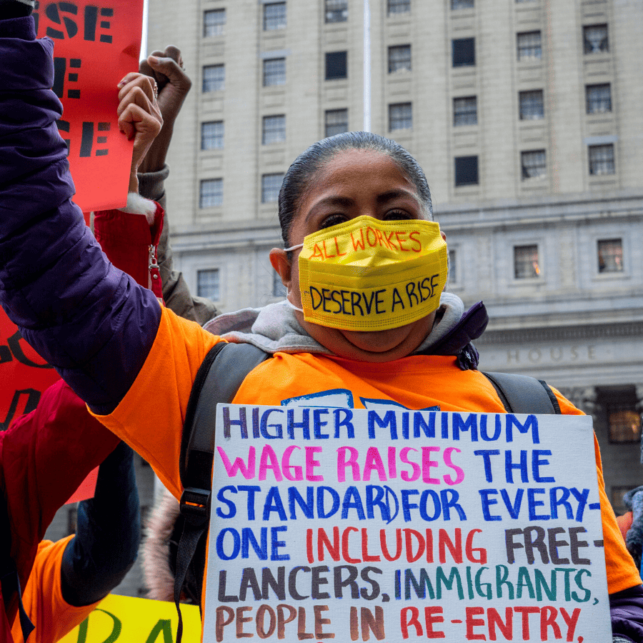
NELP is fighting to raise the wage floor so it reaches a true living wage that people and families can live on.


Good jobs that pay a living wage are the foundation of an economy that works for everyone.
But today, workers are being squeezed by rising prices and low pay. Corporations reap record profits yet choose to severely underpay their workers. Millions of people are working full-time or more but struggle to afford the basics; many must take on second or third jobs to scrape by.
NELP is fighting for higher pay that people and families can live on.
We’re advocating to:

The federal minimum hourly wage is just $7.25. Congress has not increased it since 2009—15 years ago and counting.
Low wages hurt all workers and are particularly harmful to Black workers and other workers of color—especially women—who make up a disproportionate share of workers who are severely underpaid.
It’s time that elected lawmakers in Congress pass the Raise the Wage Act, to gradually raise the federal minimum wage to $17 an hour by 2028 and end the subminimum wage for tipped workers and disabled workers.
per hour is the federal minimum wage; it hasn’t gone up in 15 years.
states follow the federal minimum wage; they have not raised wages above $7.25.
per hour is the federal subminimum wage for tipped workers; it hasn’t changed since 1991.

Millions of workers are not receiving overtime pay despite working more than 40 hours a week. The erosion of overtime pay is a key factor in the deterioration of middle-class wages and living standards.
Reform of the nation’s overtime rules is much needed and long overdue. We want to make more workers eligible for overtime pay, by fighting to:

Find out what wage campaigns are happening at the federal, state, and local levels around the country.

We’re fighting to make more workers eligible for overtime pay under federal law, and we’re urging states to restore overtime pay to farmworkers, education workers, and others long excluded.

Some state legislatures are blocking local communities from adopting higher wage standards and other worker protections.
The current federal minimum wage is $7.25 per hour, which translates to only $15,080 in pre-tax annual earnings for a full-time, year-round worker.
The federal minimum wage was signed into law by President Franklin Delano Roosevelt as part of the Fair Labor Standards Act of 1938, at the height of the Great Depression. Its stated purpose was to keep U.S. workers out of poverty, serve as a thriving wage and increase consumer purchasing power to stimulate the economy.
Raising the minimum wage at the federal level requires an act of Congress. Raising the minimum wage in states or localities typically requires state or local legislation or a ballot initiative—and in the case of localities, they may also need the legal power to raise wages above the state floor.
An estimated 28 million workers—nearly 1 in 5 working people in the U.S.—would get a much-needed raise. That’s 16.7 million women (23.5 percent of wage-earning women) and 11.1 million men, according to the Economic Policy Institute’s analysis of a recent proposal to raise the federal minimum wage to $17 by 2028. Around 30 percent of Black workers and 25 percent of Latino workers would benefit.
Thirty states and the District of Columbia have raised their minimum wages above the federal rate of $7.25 per hour. Five states—Alabama, Louisiana, Mississippi, South Carolina, and Tennessee—have no state minimum wage laws at all. In all states, employers who are covered by the law are required to pay the state minimum wage or the federal minimum wage—whichever is higher.
The federal minimum wage was last raised on July 24, 2009, when it rose from $6.55 to $7.25 per hour, the last step of a three-step increase approved by Congress in 2007. Before 2007, the minimum wage had been stuck at $5.15 per hour for 10 years.
Frustrated by inaction at the federal level, states and, increasingly, many cities and counties have moved to raise the wage floor. Twenty-eight states have raised their minimum wage since the last federal increase—some through legislation or ballot initiatives, and others through having adopted “indexing” provisions that authorize small automatic increases to the local minimum wage most years to keep pace with the rising cost of living.
The strongest momentum in recent years has been at the local level. Altogether, 60 cities and counties have raised the minimum wage locally since 2012, and at least 17 since 2020. See our report, Raises from Coast to Coast in 2024.
The value of the federal minimum wage has fallen sharply over the past 56 years. In 1968, when its purchasing power was at its peak, the federal minimum wage was $1.60 per hour, which translates to approximately $14.47 in 2024 dollars.
Indexing the minimum wage to inflation means adjusting it automatically to keep pace with the rising cost of living so that workers do not lose purchasing power each year.
Nineteen states plus the District of Columbia have adopted laws to index their minimum wages to rise automatically with the cost of living. Fifteen states plus the District of Columbia currently index minimum wage increases each year: Alaska, Arizona, California, Colorado, Connecticut, Maine, Minnesota, Missouri, Montana, New Jersey, Ohio, Oregon, South Dakota, Vermont, and Washington.
Six more states will index minimum wage increases annually beginning in future years: Florida (2027), Nebraska (2027), New York (2027), and Virginia (2026). The remaining states and the federal government, however, have not yet indexed their minimum wages.
Minimum wage increases stimulate the economy by increasing consumer spending without adding to state and federal budget deficits. Consumer spending drives 70 percent of the economy, and increasing demand is key for jumpstarting and maintaining production and hiring. A raise in the minimum wage puts money into people’s pockets, and that money gets spent at local businesses.
The Economic Policy Institute estimates that the Raise the Wage Act, which would raise the federal minimum wage to $17 per hour by 2028, would result in wage increases totaling more than $86 billion for roughly 28 million workers in communities across the country.
Raising wages reduces costly employee turnover and increases productivity. When the minimum wage goes up, employers can reap such benefits without being placed at a competitive disadvantage, because all companies in their field are required to do the same.
Research has documented how, especially in underpaid industries, raising wages reduces turnover, because workers who are paid more stay with their current employer longer. A 2003 study of the effect of a wage increase for workers at the San Francisco Airport, for example, found that annual turnover among security screeners plunged from 95 percent to 19 percent after their hourly wage rose from $6.45 to $10 per hour. This reduced labor market churn yields significant savings for employers by reducing recruitment, re-training, and re-staffing costs. Researchers and trade association analysts have found these savings for employers to be significant, even in underpaid sectors.
Federal law and most states’ laws allow employers to pay a lower minimum wage to workers who typically receive tips from customers. These lower minimum wage rates are variously known as the tipped wage, subminimum tipped wage, or base cash wage.
A “tip credit” allows employers to pay workers less than the full minimum wage. Under current federal law, for example, employers can pay tipped workers $2.13 an hour. That’s because employers take a tip credit of $5.12—the difference between the full $7.25 minimum wage and the $2.13 tipped wage.
Although subminimum tipped wage laws allow employers to pay a reduced minimum wage, they also require them to “top off” those workers if their base wage plus tips fall short of the applicable minimum wage.
Originally, the federal tipped-worker minimum wage was 60 percent of the full minimum wage. Since 1991, however, it’s been stuck at just $2.13 per hour. Because it hasn’t been increased at all in over three decades, its relative value has plummeted to less than 30 percent of the federal minimum wage.
Thirty-four states plus the District of Columbia provide stronger protections for tipped workers by requiring that tipped workers be paid above the federal rate. Illinois, for example, guarantees tipped workers 60 percent of the minimum wage, and Maine, Missouri, Ohio, South Dakota, and Vermont guarantee 50 percent. In seven states—Alaska, California, Minnesota, Montana, Nevada, Oregon, and Washington—tipped workers are guaranteed the full minimum wage—a best practice that has reduced poverty among tipped workers in those states. The remaining 16 states, however, provide far less protection, as they follow the shamefully low $2.13 federal rate.